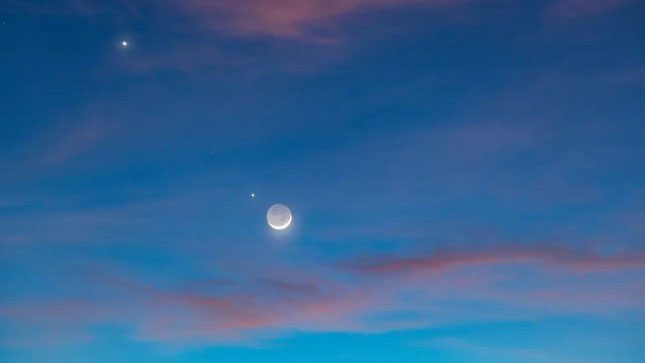At the beginning of July, the Moon passed near three neighboring planets within the Solar System and will approach the two largest planets orbiting the Sun this month.
First, the gas giants Saturn and Jupiter can be observed next to the Moon just before sunrise in early July. By the end of July, Mercury, Venus, and Mars will shine close to the crescent Moon after sunset.

The Moon, Earth combined with Jupiter and Venus. (Photo: Getty).
The Moon Approaches Venus, Jupiter, Mercury, Mars, and Saturn
First Conjunction (an astronomical event where two objects appear close together in Earth’s night sky) of the Moon and a planet occurs on July 7, when the waning Moon illuminated at 80% will be seen just below Saturn. These two objects will rise in the southeastern night sky in the early morning and will remain visible until dawn.
On July 11, the waning Moon with 37% illumination, positioned slightly above Jupiter, will rise in the east late at night. The following morning, the Moon will decrease in brightness to 27% and can be seen just below Jupiter.
Mercury, Venus, and Mars – three other rocky planets in the Solar System – will be tightly grouped with the crescent Moon in the western night sky from July 19 to July 21 in the early evening.
However, since the crescent Moon will only be illuminated at 5% on July 19, this will be the most challenging night to observe near the rocky planets. This also holds true for Mercury, which will be very low on the horizon. Nevertheless, Venus will shine brightly next to the crescent Moon, while Mars will be easily visible above. Do not confuse Mars with Regulus, the brightest star in the constellation Leo, which will be located between Venus and Mars.
Using binoculars, find a clear view toward the western horizon and begin observing about 35 minutes after sunset, according to a website run by astronomer Jeffrey Hunt.
On July 20 – the 54th anniversary of Apollo 11’s first moon landing, the crescent Moon will be much more visible. Besides being illuminated at 10%, the Moon will rise higher and will shine alongside Mars, just above Venus. Mercury will remain low on the west-northwest horizon.
While you are observing the trio of planets, look for “Da Vinci light“ on the dark edge of the Moon. Also known as Earthshine, this phenomenon is caused by sunlight reflecting off Earth’s oceans, clouds, and ice.
On the evening of July 21, the crescent Moon with 16% illumination will appear even higher on the western horizon, but it will align with Mars and Venus. Mercury will be to the right of Venus.
In the following nights, the Moon will rise higher in the sky after sunset, with Venus shimmering in the bright sunlight while Mercury continues to emerge above it.
On July 28, Mercury will shine only one-tenth the brightness of Regulus at sunset. It promises to be a spectacular sight, even to the naked eye.


















































